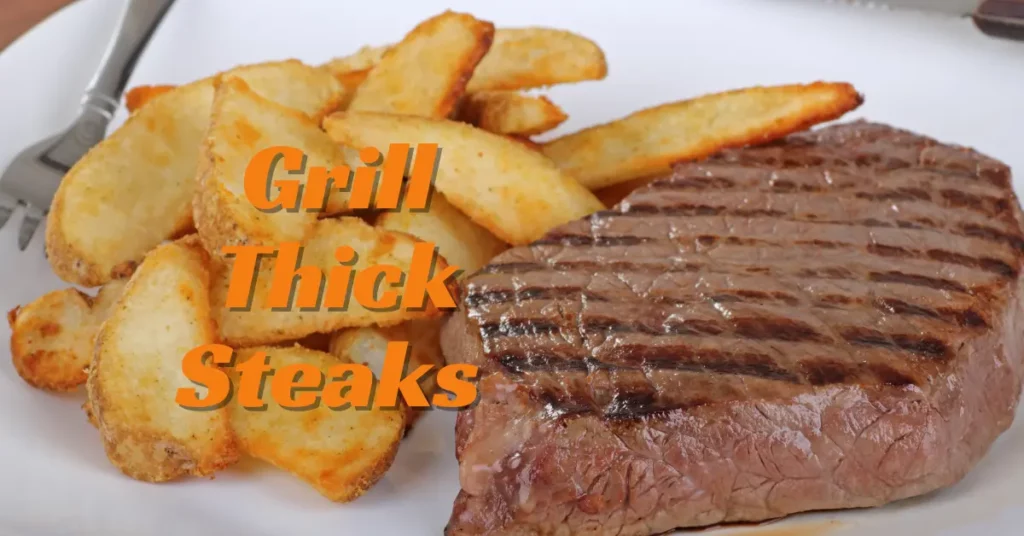This post may contain affiliate links. If you use these links to buy something we may earn a small commission. Thanks.
Grilling a thick steak to perfection is an art that requires a balance of heat, timing, and technique. Unlike thinner cuts, thick steaks need special attention to ensure a rich seared crust while maintaining a juicy, tender interior. Whether you’re cooking a ribeye, filet mignon, or porterhouse, this guide will walk you through everything you need to know about grilling thick steaks on a gas grill.
Choosing the Right Steak
The first step to grilling an excellent steak is choosing the right cut. While any steak can technically be cooked on a gas grill, some cuts are better suited for grilling than others.
Recommended Cuts:
- Ribeye – Well-marbled, rich in flavor, and juicy.
- Filet Mignon – Lean but exceptionally tender.
- Porterhouse – A combination of tenderloin and strip steak, offering the best of both worlds.
- New York Strip – Slightly less fatty than ribeye but still flavorful with a great texture.
Ideal Thickness:
For optimal grilling, choose steaks that are 1.5 to 2 inches thick. This thickness allows for a deep sear while still achieving the perfect internal temperature without overcooking.

Marbling and Quality:
- Choose USDA Prime or USDA Choice for the best flavor and tenderness.
- More marbling (intramuscular fat) means more flavor.
Preparing the Steak
Before your steak ever hits the grill, proper preparation is key to ensuring an even cook and the best possible flavor.
Thawing and Bringing to Room Temperature
- If your steak is frozen, allow it to thaw completely in the refrigerator for 24 hours.
- Before grilling, let the steak sit at room temperature for at least 30-45 minutes. This helps it cook evenly and prevents a cold center.
Seasoning the Steak
You don’t need to overcomplicate the seasoning. The best steaks highlight their natural flavor.
- Basic Seasoning: Generously coat both sides with coarse salt and black pepper.
- Additional Flavor: Garlic powder, onion powder, smoked paprika, or fresh herbs.
- When to Season:
- At least 40 minutes before cooking – Allows salt to break down proteins and enhance moisture retention.
- Right before grilling – If you’re short on time, season just before placing it on the grill.
Preheating the Gas Grill
A well-heated grill is essential for a perfect sear.
- Turn all burners to high and close the lid for 15 minutes.
- Set up a two-zone fire:
- One side on high heat (for searing).
- One side on medium-low heat (for indirect cooking).
- Oil the grates using a high smoke point oil (canola or avocado oil) on a paper towel and tongs.
Grilling the Steak
Searing on High Heat
To develop a rich crust:
- Place the steak on the hot side of the grill.
- Sear for 2-3 minutes without moving it.
- Flip the steak and sear for another 2-3 minutes.
- Rotate for crosshatch grill marks (optional).
Finishing Over Indirect Heat
Once a crust has formed, move the steak to the cooler side of the grill.
- Close the lid and allow it to cook to the desired doneness.
- Use a meat thermometer for accuracy:
- Rare: 120-125°F (5-7 minutes)
- Medium Rare: 130-135°F (7-9 minutes)
- Medium: 140-145°F (9-11 minutes)
- Medium Well: 150-155°F (11-13 minutes)
- Well Done: 160°F+ (13+ minutes)
Resting and Serving
Why Resting is Crucial
After grilling, let the steak rest for 5-10 minutes before slicing. Resting allows the juices to redistribute, keeping the steak moist and tender.
How to Serve the Steak
- Slice against the grain for maximum tenderness.
- Add finishing touches like a pat of butter, fresh herbs, or a drizzle of olive oil.
- Pair with side dishes like grilled vegetables, mashed potatoes, or a fresh salad.
Additional Tips for Perfect Steaks
- Use Compound Butter – Mix butter with garlic, herbs, and spices to enhance flavor.
- Reverse Sear Method – Start cooking on indirect heat first, then finish with a high-heat sear.
- Avoid Over-Flipping – Flip only once to develop a proper crust.
- Check the Heat Zones Regularly – Adjust burners as needed to maintain temperature.
Conclusion
Grilling thick steaks on a gas grill is all about the right technique. By choosing the right cut, properly seasoning, using two-zone grilling, and monitoring temperature, you can achieve a steakhouse-quality result right at home. Now, fire up your grill and enjoy a perfectly grilled thick steak.
